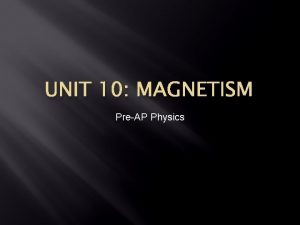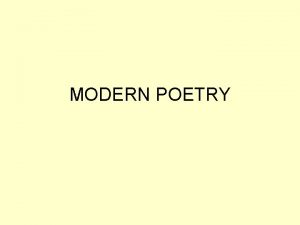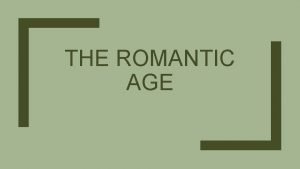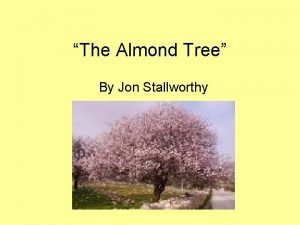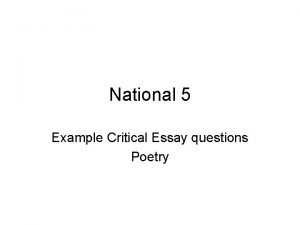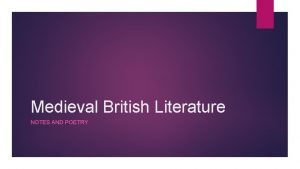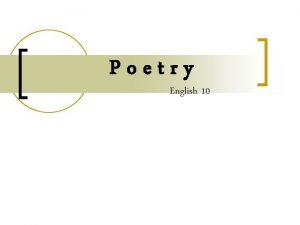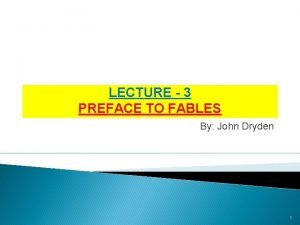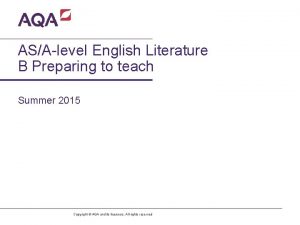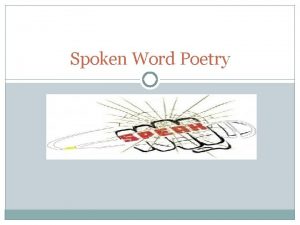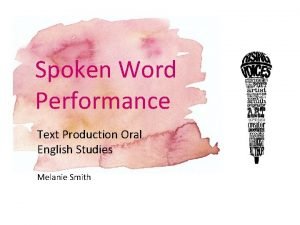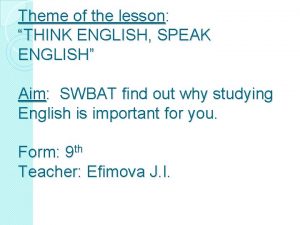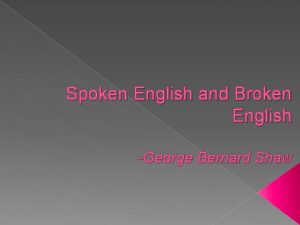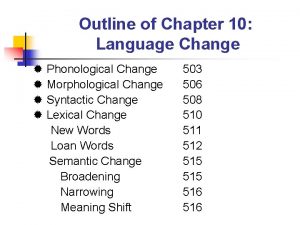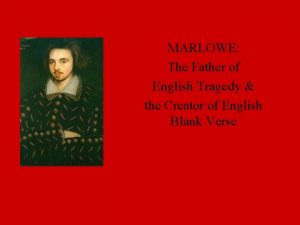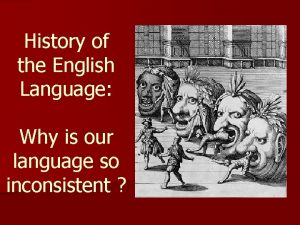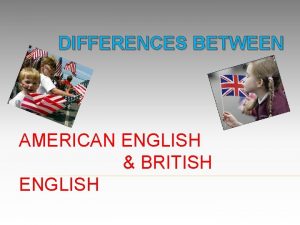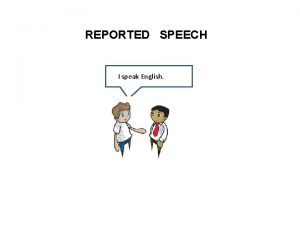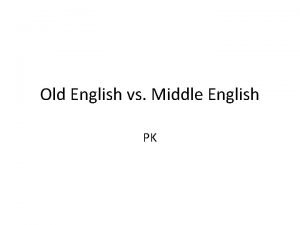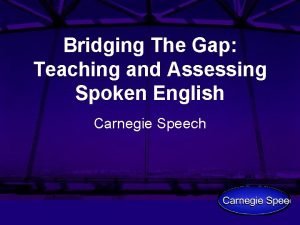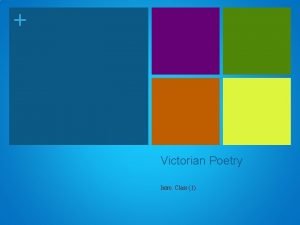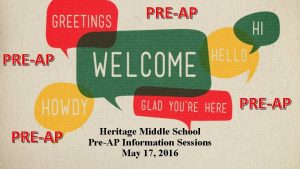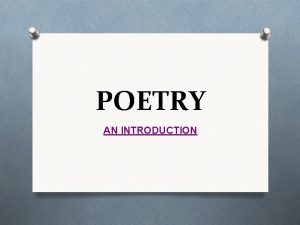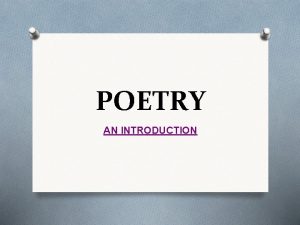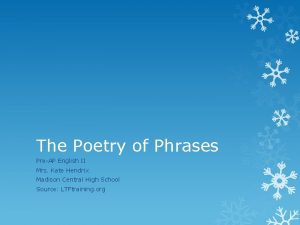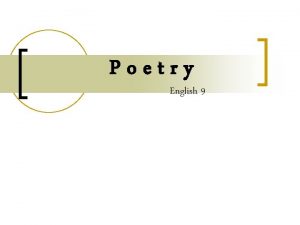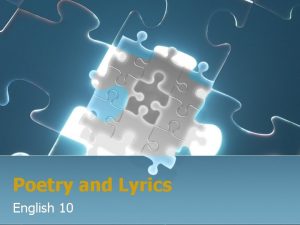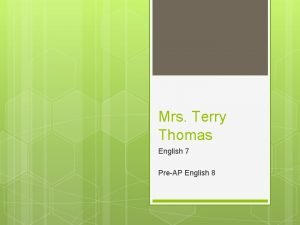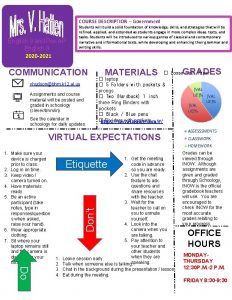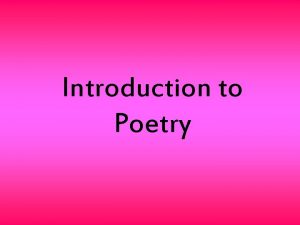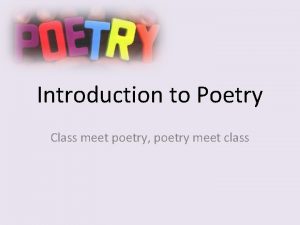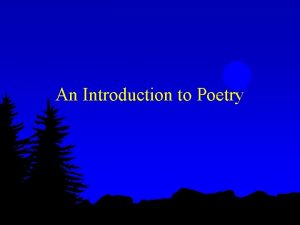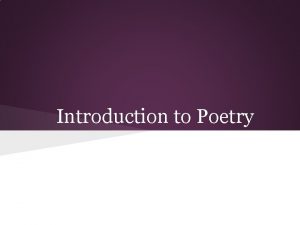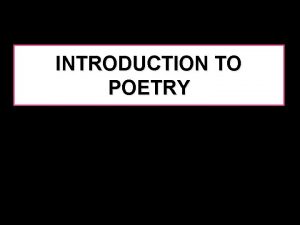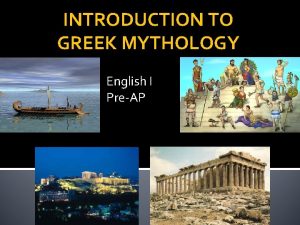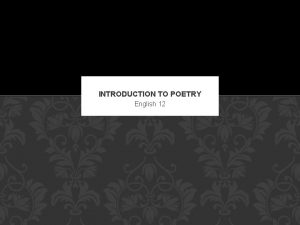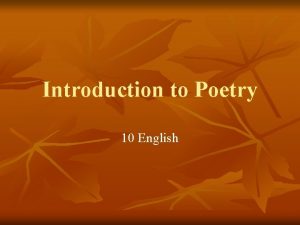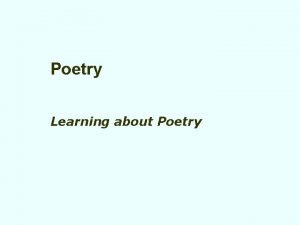Introduction to Poetry 9 th PreAP English Poetry































- Slides: 31

Introduction to Poetry 9 th Pre-AP English

Poetry: A Definition n n Length Visual impressions Concentrated, intense language that makes deliberate sound effects which can involve rhythm, rhyme, or other sounds Written in lines and stanzas rather than sentences or paragraphs Meaning is gleaned from understanding the use of metaphor, symbol, imagery, etc.

Poetry: A Definition n n Subject matter can cover the intellectually safe or the profane; the marginal or society Fixed or free form n n Fixed form is a poem that may be categorized by the pattern of its lines, meter, rhythm, or stanzas; a style of poetry that has set rules. Ex: sonnet, villanelle, limerick Free Form is a poem that has neither regular rhyme nor regular meter. Free verse often uses cadences rather than uniform metrical feet.

Subject Matter of Poems n n n n Love Poem, Political Poem, Metaphysical Poem, Confessional Poem Elegy (poem that reflects on death or solemn themes) Epithalamion (poem that praises a wedding) Proverb (a poem that imparts wisdom, learning, and aid memory) Found poem (poems that are discovered in everyday life) Pun (word play, humor, or cleverness--“Pasteurize: Too far to see. ”) Epigram (short, witty, concise saying—can be sarcastic or parodic, about a person or an idea— “Swans sing before they die--'twere no bad thing / should certain people die before they sing!”)

How do you read a poem? from pg. 489 in your text n n Look for punctuation in the poem telling you where sentences being and end. Do not make a full stop at the end of a line if there is no period, comma, colon, semicolon, or dash there. If a passage of a poem is difficult to understand, look for the subject, verb, and complement of each sentence. Be alert for comparisons— for figures of speech. n n n Read the poem slowly and out loud to help hear the “musicality” of the poem. Be patient, for poems can be ambiguous or confusing. Talk about it with others who have read it, when possible. Read the poem several times.

Looking at a Poem n Hearing the Words Rhyme (end, internal, approximate) n Rhyme scheme (Roses are red. . . abcb) n Neologism (a new word or expression) http: //www. wordspy. com/diversions/ne ologisms. asp n Oxymoron n n Microsoft Works , Bitter Sweet, Anarchy Rules! http: //www. oxymoronlist. com/

Looking at a Poem n Hearing the Words, con’t n n n Inversion - Beautiful is she. Assonance - how now brown cow Consonance - Whose woods these are I think I know. Alliteration - She sells seashells by the seashore Onomatopoeia - snap, crackle, pop

A few words on diction. . . Connotation Denotation Snake evil or danger any of numerous scaly, legless, sometimes venomous reptiles; having a long, tapering, cylindrical body and found in most tropical and temperate regions

n Looking at a Poem Lines n End-stopped n n Enjambment n n Let me not to the marriage of true minds Admit impediments. Love is not love Which alters when it alteration finds Or bends with the remover to remove. —Shakespeare Flow of language and the Sound of the Poem n n My mistress' eyes are nothing like the sun. Coral is far more red than her lips red. –Shakespeare cadence -- the drum beat of words caesura-- E. B. Browning: “How do I love thee? //Let me count the ways. ” dissonance - Are you lamenting because your enjambment is not working in your couplet? Meter n n Fixed form Iambic pentameter (blank verse with 5 feet of iambs—da. DUM—But soft, what light through yonder window breaks? ) Free verse (aka Free form) NOTE: see page 740 – 741 in your book

Refrain Looking at a Poem Quoth the raven, "Nevermore. “ Synaesthesia / Synesthesia ‘a deafening yellow’; ‘sunburnt mirth” Epithet swift-footed Achilles; rosy-fingered dawn; Ivan the Terrible

Looking at a Poem n n Lines - a single line of poetry. Stanzas - a group of lines set off from the other lines in a poem; the poetic equivalent of a paragraph in prose. In traditional poems, the stanza usually contains a unit of thought, much like a paragraph. n Tercet n n n The winged seeds, where they lie cold and low, Each like a corpse within its grave, until Thine azure sister of the Spring shall blow Punctuation – used for emphasis Structure of images / symbols within the poem n Watch for colors, patterns, figurative language

Types of Poems FIXED FORM POEMS n Sonnet n n 14 -line poem with specific rhyme scheme English (a. k. a. Shakespearean) n ababcdcdefefgg (three quartrains and a couplet) n Italian (a. k. a. Petrarchan) n abbacdecde (octet, sestet, volta is between lines 8 and 9) n

Example of Sonnet Shakespeare’s Sonnet 116 Let me not to the marriage of true minds Admit impediments. Love is not love Which alters when it alteration finds, Or bends with the remover to remove: O no! it is an ever-fixed mark That looks on tempests and is never shaken; It is the star to every wandering bark, Whose worth's unknown, although his height be taken. Love's not Time's fool, though rosy lips and cheeks Within his bending sickle's compass come: Love alters not with his brief hours and weeks, But bears it out even to the edge of doom. If this be error and upon me proved, I never writ, nor no man ever loved.

Types of Poems n n FIXED FORM POEMS Haiku – Japanese poem with 17 syllables -first line has 5, second has 7, last line has 5. n n It combines form, content, and language in a meaningful, yet compact form Haiku doesn't rhyme. A Haiku must "paint" a mental image in the reader's mind. A Rainbow by Donna Brock Curving up, then down. Meeting blue sky and green earth Melding sun and rain.

Types of Poems n FIXED FORM POEMS n Cinquain: a poem with five lines n Line 1 is one word (the title) Line 2 is two words that describe the title. Line 3 is three words that tell the action Line 4 is four words that express the feeling Line 5 is one word that recalls the title Tree Strong, Tall Swaying, swinging, sighing Memories of summer Oak

Types of Poems n n FIXED FORM POEMS Villanelle - 19 lines long, but only uses two rhymes, while also repeating two lines throughout the poem. The first five stanzas are triplets, and the last stanza is a quatrain such that the rhyme scheme is as follows: "aba abaa. " The tricky part is that the 1 st and 3 rd lines from the first stanza are alternately repeated such that the 1 st line becomes the last line in the second stanza, and the 3 rd line becomes the last line in the third stanza. The last two lines of the poem are lines 1 and 3 respectively, making a rhymed couplet. Confused? A villanelle needs no particular meter or line length. It is terribly obsessive and can bring out the emotions of any neurotic writer.

Example of a Villanelle “Do Not Go Gentle Into That Good Night” Do not go gentle into that good night, Old age should burn and rave at close of day; Rage, rage against the dying of the light. By Dylan Thomas Though wise men at their end know dark is right, Because their words had forked no lightning they Do not go gentle into that good night, Good men, the last wave by, crying how bright Their frail deeds might have danced in a green bay, Rage, rage against the dying of the light. Wild men who caught and sang the sun in flight, And learn, too late, they grieved it on its way, Do not go gentle into that good night, Grave men, near death, who see with blinding sight Blind eyes could blaze like meteors and be gay, Rage, rage against the dying of the light. And you, my father, there on the sad height, Curse, bless, me now with your fierce tears, I pray. Do not go gentle into that good night, Rage, rage against the dying of the light.

Types of Poems n Dramatic Monologue: a poem in which a single speaker who is not the poet utters the entire poem at a critical moment. The speaker has a listener within the poem, but we too are his/her listener, and we learn about the speaker's character from what the speaker says. In fact, the speaker may reveal unintentionally certain aspects of his/her character. Robert Browning perfected this form.

Example of Dramatic Monologue n “My Last Duchess” by Robert Browning n “Ain’t I a Woman? ” by Sojourner Truth n n See page 611 in your textbook “Lucinda Matlock” by Edgar Lee Masters n See page 607 in your textbook

Types of Poems n Ode: usually a lyric poem of moderate length, with a serious subject, an elevated style, and an elaborate stanza pattern. There are various kinds of odes. The ode often praises people, the arts of music and poetry, natural scenes, or abstract concepts.

Types of Poems n n Elegy: a sad and thoughtful poem lamenting the death of a person. Limerick: short sometimes bawdy, humorous poems consisting of five anapestic lines. Lines 1, 2, and 5 of a limerick have seven to ten syllables and rhyme with one another. Lines 3 and 4 have five to seven syllables and also rhyme with each other.

Example of Limerick There was an Old Person whose habits, Induced him to feed upon rabbits; When he'd eaten eighteen, He turned perfectly green, Upon which he relinquished those habits. http: //www. types-of-poetry. org. uk/examples-of-limericks. htm

Types of Poems n Ballad (folk and literary) Randall’s “The Ballad of Birmingham” n Epic – Homer’s Illiad and Odyssey n Diamante n Concrete Poem

Example of Concrete Poem n n Bird #3 by Don J. Carlson Poe's raven told him nothing nevermore and Vincent's circling crows were a threat to destroy sunlight. Now I saw a bird, black with a yellow beak, orange rubber legs pecking to kill the lawn, storm bird hates with claw, evil beak, s u n and eye

Figures of Speech n n Simile – She’s as big as a house. Metaphor – n n n Direct: She’s a brick house. Implied: The man brayed his refusal to leave. (because the subject--the man--is never overtly identified as a mule) Extended: See the next slide “Catch” Dead: tying up loose ends, a submarine sandwich, a branch of government, and most clichés Mixed: The movie struck a spark that massaged the audience's conscience. Personification – The house creaked with old age.

Example of an extended metaphor n n “Catch” by Robert Francis Two boys uncoached are tossing a poem together, Overhand, underhand, backhand, sleight of hand, everyhand, Teasing with attitudes, latitudes, interludes, altitudes, High, make him fly off the ground for it, low, make him stoop, Make him scoop it up, make him as-almost-as possible miss it, Fast, let him sting from it, now fool him slowly, Anything, everything tricky, risky, nonchalant, Anything under the sun to outwit the prosy, Over the tree and the long sweet cadence down, Over his head, make him scramble to pick up the meaning, And now, like a posy, a pretty one plump in his hands. Robert Francis' poem "Catch" relies on an extended metaphor that compares poetry to playing catch. A controlling metaphor runs through an entire work and determines the form or nature of that work. '

Examples of Language n Metonymy (one term for another with which it is commonly associated or closely related. ) n n the pen is mightier than the sword the crown (referring to a Queen or King) all hands on deck Synecdoche (part for the whole) n n give us this day our daily bread The U. S. won three gold medals. (Instead of “The members of the U. S. boxing team won three gold medals. ”)

Irony, doncha think? Irony involves a contradiction. "In general, irony is the perception of a clash between appearance and reality, between seems and is, or between ought and is. ” Verbal irony--Saying something contrary to what it means. In daily language, being ironic means that you say something but mean the opposite to what you say. "Oh, how lucky we are to have SO MANY AP classes to choose from!" Depending on how you say it, there is a contradiction between your literal meaning and your actual meaning--and this is what we call verbal (rhetoric) irony. Dramatic irony -- Saying or doing something while unaware of its ironic contrast with the whole truth; verbal irony with the speaker's awareness erased" -- so that the irony is on the speaker him/herself, but not what s/he talks about. Situational irony-- Events turning to the opposite of what is expected or what should be. The ironic situation --the "ought" upended by the is -- is integral to dramatic irony. In Alanis Morissete's “Ironic" we can see a lot of situational ironies -- or ironies of fate. Cool article explaining the song "Ironic"

Watch Your Tone! n "The word tone in literary discussion is borrowed from the expression tone of voice. Tone is the manner in which a poet makes his statement; it reflects his attitude toward his subject. Since printed poems lack the intonations of spoken words, the reader must learn to "hear" their tones with his mind's ear. Tone cannot be heard in one particular place since it reflects a general attitude, it pervades the whole poem. " (Poems: Wadsworth Handbook and Anthology by C. F. Main & Peter J. Seng)

Hey, DIDLS diddle. . . n n n Use DIDLS to consider the tone of a poem. Diction—the connotation of the word choice Consider the following when discussing diction n n n n · · monosyllabic/polysyllabic colloquial/informal/formal denotative/connotative euphonious/cacophonous Images—vivid appeals to understanding through the senses Details—Facts that are included or omitted Language—The overall use of language, formal, colloquial, clinical, jargon, etc. . . Sentence Structure—How structure affects the reader’s attitude

TPCASTT n We’ll save this for another powerpoint ; ) One last note. . . n SPEAKER The speaker of the poem IS NOT necessarily the poet. It is a persona (a character) used to “voice” the poem. The speaker addresses an audience or another character. Identify and describe the speaking voice or voices, the conflicts or ideas, and the language used in the poem. n
 Preap magnetism 1
Preap magnetism 1 Ap/pre ap definition
Ap/pre ap definition Cavalier and metaphysical poetry
Cavalier and metaphysical poetry Experimentation in modern poetry
Experimentation in modern poetry Lyric poetry tells a story
Lyric poetry tells a story Augustan and romantic literature
Augustan and romantic literature The almond tree poem
The almond tree poem National 5 english critical essay questions poetry
National 5 english critical essay questions poetry British literature notes
British literature notes Crocus poem
Crocus poem Edexcel english literature gcse past papers
Edexcel english literature gcse past papers Allama iqbal presentation
Allama iqbal presentation Hyperbole
Hyperbole Preface to the fables
Preface to the fables Characteristics of romantic literature
Characteristics of romantic literature Social and political protest writing examples
Social and political protest writing examples Spoken poetry english
Spoken poetry english Oral english text
Oral english text Yesterday poem by patricia pogson
Yesterday poem by patricia pogson Think english speak english
Think english speak english Spoken english and broken english
Spoken english and broken english Semantic change
Semantic change Cut is the branch that might have grown explanation
Cut is the branch that might have grown explanation Old english vs modern english
Old english vs modern english Differences between americans and british
Differences between americans and british Differences between american and british english vocabulary
Differences between american and british english vocabulary Old english vs modern english
Old english vs modern english “i speak english” he said that he ……english
“i speak english” he said that he ……english Thy thou thee old english
Thy thou thee old english The gap between written and spoken english
The gap between written and spoken english British english
British english Intro
Intro
